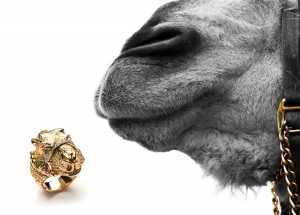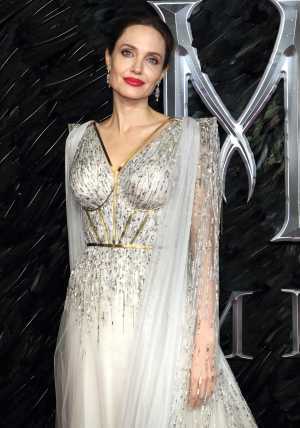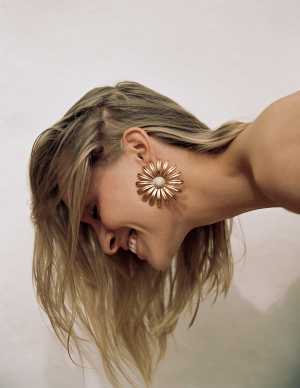Sabine Roemer was personally commissioned by Nelson Mandela for the final three years before his death to create special artworks for his birthday.
The last of which he never lived to see, but now – ten years on and inspired by her last conversations with him before his passing – Roemer has decided to go forward with the final work, a sculpture in bronze. Only eight pieces will be cast, the proceeds of which will benefit African charitable projects.
What is perhaps most impressive about all this is that Roemer is not even a sculptor by trade. At least, not originally. Her first passion was for jewellery, which proved to be a springboard to take her everywhere from Harrods to Hollywood.
We caught up with the designer to find out more.
SM: When did you decide you wanted to be a jeweller?
SR: I truly fell in love with the craftsmanship of making jewellery when I was 15. I did work experience at a workshop in my hometown Karlsruhe, Germany. In those five days I made six pieces; I was only tasked to make one. So I knew I found my vocation.
I truly feel connected to each piece because they all tell a story of the everlasting. Being able to mould natural elements that were born at the beginning of time, into something that will live on perpetually after their extraction, reminds me of the fleetingness of human life.
I wanted to do this for the rest of my life and started my apprenticeship in the same workshop, where I was awarded a scholarship and only a few years later I finished my Master’s degree at the age of 23 – and became the youngest female Master at the time.
SM: Wow – 15 is pretty young to start a career! You must have had a good mentor…?
SR: I know - I can’t believe that next year it will be 30 years that I have been doing this.
I’m deeply grateful to my first boss, Dietmar Kohn, who at the time told me: “The trade is dying but you have something special, so keep going, and I will guide you.”
I started to express myself with forging metal, carving stones and forming wax and clay, which all came very naturally to me. I had always painted, crafted and even made my own clothes but I seem to be drawn and guided by metal and gemstones – they were almost speaking to me.
I love capturing moments and stories and freezing them in time through craft. There is no other medium that can withstand the passing of time.
SM: You’ve worked all over the world; how come you settled on London?
SR: I travelled the globe and have lived in Australia, Greece, Austria and the States, but I always loved London. I remember when I was 17 on a school trip to London, I knew I would end up here one day.
After I finished my master’s degree I took my first job in London with Stephen Webster and a few years after I settled. I started to do solely work under my own name aged 27.
The first pieces I made during that time were created by using parts from Formula 1 cars, and making cufflinks, bracelets and other jewellery from them.
The hero piece was a baseball cap for the Monaco grand prix, with the F1 logo set with diamonds. I also made a lot of pieces for footballers such as Michael Ballack.
SM: In 2010, aged 30 you debuted your first high jewellery collection in Harrods. That’s quite the impressive place for a debut. How did you manage to get your foot in the door at the world’s most famous department store?
SR: It was a dream come true to show my first collection, Arabian Nights, at Harrods. This Middle East-inspired collection even included a diamond-encrusted falcon hood! And from this collection I still wear my Camel ring everyday – it makes me smile [see below].
It all started when I was 27 and I met Mr Al Fayed by chance. He was walking around Harrods while I was shopping; he asked what I thought of a certain collection I was looking at and we got talking. When he found out I was a jeweller, he wanted to know more.
He loved my work and believed I could create something different for his clientele. His unwavering support made my dream come true. It took me three years to make the collection and was one of the most important career turning points of my life.

SM: You’ve created pieces for Prince Harry, Prince William, and the late Queen Elizabeth II. Can you give us any insights/anecdotes from working with the royal family?
SR: After making my first “mini jewellery sculpture” for Nelson Mandela, I realised that I can take part in making a difference through my work. I really love how the Royal Family uses their power and presence to make a difference. Their philanthropic work and impact is really impressive. So for me to play a small part in that, working closely with them to capture their patronage, is very special.
SM: When did you start moving into sculpture as an art form?
SR: I think I always had it in me, as it was a key part of my training as a gold- and silversmith. I am drawn to making bigger pieces such as a crown or a candle stick, and even a mini carousel. My camel and horse rings are more mini sculptures than traditional jewellery.
However, to go as big as I have now with my latest Bronze sculpture, meant I had to learn how to start from clay as opposed to working straight from metal or stone.
The truly talented Jonathan Wylder helped show me the process and guided me in the steps in his workshop. And a few years later, I have finally finished my first bronze sculpture “Nelson Mandela – the Long Walk to Freedom”. It’s limited to eight pieces, and I just delivered the first one to actor Morgan Freeman, who has been really supportive of my work.
SM: What was your first commission?
SR: I think I was still an apprentice aged around 16 or 17 and my best friend’s step mum gave me her engagement ring to reset and update its design, giving it a more modern twist.
SM: And what’s been your favourite?
There are so many it’s hard to choose your favourite. But a particular one I am fond of was a beautiful headpiece with a 360-carat Emerald in the centre [see picture below].
Also when I created a bespoke “46664” (Mandela’s prison number) bangle for Morgan Freeman, which he wore to the Academy Awards.
Another project I loved was repurposing a brooch belonging to the Queen of Sweden, turning it into an intricate sculpted Orchid, which is her favourite flower.
I always love commissions, where I can push myself, tell a story or work with a very rare stone. Each piece gives an energy to its wearer and transforms the story into a legacy no matter how big or small – there is a special power between jewellery and humankind.
SM: How did you come to create a bespoke hand-carved golden corset for Angelina Jolie? How does that conversation even start?!
SR: My good friend Tamara Ralph, the couturier, called me and told me about her idea. First I was not quite sure if this was possible given the timeframe.
But we made it happen, after more than 50 hours spent hammering and moulding the corset into the exact shape so it fit her body perfectly. It was a stunning dress and she wore it to the premiere of Disney’s Maleficent movie.

ZUMA Press Inc / Alamy Stock Photo
SM: Who are your biggest professional influences – and how have they influenced you?
SR: Naturally I keep up to date with the goings-on in my own industry, as well as the design, art and architecture worlds. I have a lot of interests and I constantly consume the work of creative people around me, but I can’t say anyone influences me in particular.
Of course there are people like JAR (Joel Arthur Rosenthal), who was so forward thinking in his jewellery for that time, and such an elusive and exclusive name to be able to own.
I am also inspired by the work of designer Kelly Wearstler. But I don’t really follow trends; I just follow my heart and hands.
SM: How did ROMY LONDON come about?
SR: I was pregnant with my first daughter Romy when I was shopping for my mother’s upcoming birthday. As I looked around for jewellery for her, I wasn’t impressed by what was available in the demi-fine category.
Everything felt a bit too cute and not impactful enough. The fashion brands had cool designs, but it was mostly brass and had little longevity, where your skin goes green after a while as the plating rubs off.
I thought I could offer something with the same aesthetics as my high jewellery – interesting designs with a meaning. Something feminine but strong and in precious metal that you can style up and down making any look feel elevated. So ROMY was born (literally!).

SM: What was the biggest challenge of launching the business?
SR: When you’re designing, making and setting up a business all at once, while also learning so many aspects of a new (and online only) business – it’s a lot. In the beginning you need to wear so many hats. So, it means really long hours, not much of a private life and constantly learning and keeping up.
Coming from “JEWELLERY-ART” where SABINE ROEMER is a private sales and bespoke focused brand, I found that with ROMY, it was a totally different game. The jewellery still needed to have a strong identity, but with multiple collections a year. Plus, there is an added pressure to create also with visuals, such as short films and moving photography to animate the vision and turn it into something that sells at high volume.
Last year we really broke through with my dream team with video by Alice Rausch and photography by Susan Buth. I also found my perfect business partner Marleen, who shares the same vision as me – to empower people through jewellery and for it to bring out their true character.
SM: What’s been ROMY LONDON’s biggest success?
SR: The item closest to my heart was a beautiful necklace, which was launched in collaboration with supermodel and icon Elle Macpherson last year to celebrate the connection between women and their journey to find strength, wellbeing and female connectivity.
When I was sketching the "goddess" necklace, I was stuck for a long time searching for the right symbol which had a deep enough meaning for me. Then Elle came into my life and helped me through a tough time and made me see that what I needed has always been within me. She taught me the importance of inner strength.
SM: You’ve also moved into design. What are your plans in this space?
SR: When I designed our house, I really got into furniture design and designed a few pieces for the home, such as bedside tables and my atelier desk. I would love to explore more of this space, maybe through marble, leather and bronze or copper tables. I love materials that are alive and change with you.
Are there any artistic disciplines you’re keen to explore next?
I have so many passions and outlets I would love to push further, I just keep running out of time. One of them is painting, which I have always loved. I had my first exhibition when I was 17, but never found the time afterwards, except from the occasional commission from friends and clients.
SM: What’s your biggest yet unrealised ambition?
SR: I would love to create a sculpture fountain for a major city one day. One where people can gather and connect. I find water has such a calm and cleansing energy. My favourite fountains are obviously in Rome, and it would be amazing to create a masterpiece like that one day – a true challenge.
For more information, see sabineroemer.com

